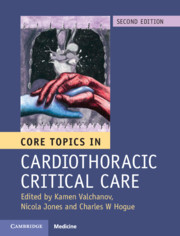Book contents
- Core Topics in Cardiothoracic Critical Care
- Core Topics in Cardiothoracic Critical Care
- Copyright page
- Contents
- Contributors
- Foreword
- Preface to the Second Edition
- Link between Cardiothoracic Anaesthesia and Intensive Care: Which Patients are Admitted to Critical Care?
- Scoring Systems and Prognosis
- Abbreviations
- Section 1 Diagnosis
- Section 2 Practical Procedures
- Section 3 Therapeutic Intervention
- Section 4 Advanced Organ Support
- Section 5 Acute Disorders
- 25A Resuscitation after Adult Cardiac Surgery
- 25B Out-of-Hospital Cardiac Arrest Patients in the Cardiothoracic Intensive Care Unit
- 26 Airway Emergencies
- 27 Chest Pain as a Symptom on the Cardiothoracic Intensive Care Unit
- 28 Acute Dyspnoea and Respiratory Failure
- 29 Shock in the Cardiothoracic Intensive Care Unit
- 30 Systemic Hypertension in Cardiothoracic Critical Care
- 31 Pulmonary Hypertension in the Cardiothoracic Intensive Care Unit
- 32 The Infected Patient
- 33 Seizures
- 34 The Acute Abdomen in the Cardiac Intensive Care Unit
- 35 Cardiothoracic Trauma
- 36 The Bleeding Cardiac Surgical Patient
- Section 6 Perioperative Care: The Patient Post Cardiac Surgery
- Section 7 Disease Management in the Cardiothoracic Intensive Care Unit: Incidence; Aetiology; Diagnosis; Prognosis; Treatment
- Section 8 Provision and Delivery of Cardiothoracic Intensive Care
- Exercise Answers
- Index
- References
28 - Acute Dyspnoea and Respiratory Failure
from Section 5 - Acute Disorders
Published online by Cambridge University Press: 15 June 2018
- Core Topics in Cardiothoracic Critical Care
- Core Topics in Cardiothoracic Critical Care
- Copyright page
- Contents
- Contributors
- Foreword
- Preface to the Second Edition
- Link between Cardiothoracic Anaesthesia and Intensive Care: Which Patients are Admitted to Critical Care?
- Scoring Systems and Prognosis
- Abbreviations
- Section 1 Diagnosis
- Section 2 Practical Procedures
- Section 3 Therapeutic Intervention
- Section 4 Advanced Organ Support
- Section 5 Acute Disorders
- 25A Resuscitation after Adult Cardiac Surgery
- 25B Out-of-Hospital Cardiac Arrest Patients in the Cardiothoracic Intensive Care Unit
- 26 Airway Emergencies
- 27 Chest Pain as a Symptom on the Cardiothoracic Intensive Care Unit
- 28 Acute Dyspnoea and Respiratory Failure
- 29 Shock in the Cardiothoracic Intensive Care Unit
- 30 Systemic Hypertension in Cardiothoracic Critical Care
- 31 Pulmonary Hypertension in the Cardiothoracic Intensive Care Unit
- 32 The Infected Patient
- 33 Seizures
- 34 The Acute Abdomen in the Cardiac Intensive Care Unit
- 35 Cardiothoracic Trauma
- 36 The Bleeding Cardiac Surgical Patient
- Section 6 Perioperative Care: The Patient Post Cardiac Surgery
- Section 7 Disease Management in the Cardiothoracic Intensive Care Unit: Incidence; Aetiology; Diagnosis; Prognosis; Treatment
- Section 8 Provision and Delivery of Cardiothoracic Intensive Care
- Exercise Answers
- Index
- References
- Type
- Chapter
- Information
- Core Topics in Cardiothoracic Critical Care , pp. 247 - 255Publisher: Cambridge University PressPrint publication year: 2018



